Perhaps, with caveats: sNfL elevation has low sensitivity and lags MRI activity by at least a month

Serum neurofilament light chain (sNfL) level correlates with the presence of gadolinium-enhancing (Gd+) MRI lesions, making the structural protein released in neuronal injury a potentially useful biomarker for research and clinical management of multiple sclerosis (MS). But while sNfL level has good specificity for the presence of active MRI lesions, it lacks sensitivity, as less than half of patients with active lesions have elevated levels. In addition, sNfL elevation usually occurs at least a month after lesions first appear on MRI.
Advertisement
Cleveland Clinic is a non-profit academic medical center. Advertising on our site helps support our mission. We do not endorse non-Cleveland Clinic products or services. Policy
These findings, from a post hoc analysis of a subset of participants in the RESTORE trial who were regularly followed with MRI and blood tests, were published online ahead of print in Neurology.
“NfL in the blood reflects disease activity in MS,” says the study’s corresponding author, Robert Fox, MD, a staff neurologist in Cleveland Clinic’s Mellen Center for Multiple Sclerosis Treatment and Research. “However, its low sensitivity for the presence of active Gd+ lesions and its delayed elevation after the appearance of radiological activity must be taken into account when considering its use as a biomarker for clinical and research purposes.”
Currently, MRI is the best method for monitoring central nervous system inflammation. However, it can be cumbersome for patients and too expensive to use for frequent monitoring. sNfL — a neuron-specific protein that enters the serum following neuronal damage — has been put forward as a promising blood biomarker candidate for use in the management of individual MS patients. However, its utility at the individual patient level has not been well understood.
The RESTORE trial (Neurology. 2014;82[17]:1491-1498) was a treatment interruption study of the monoclonal antibody natalizumab among patients with relapsing forms of MS who had been taking natalizumab the previous 12 months and had no Gd+ lesions at the start of the trial. During the study, patients either remained on natalizumab (25%), were put on an alternative immunomodulatory therapy (50%) or stopped all MS medications (25%). Data obtained from regular blood tests and MRI scans during the trial presented the opportunity to analyze the relationship between sNfL levels and MRI findings over time.
Advertisement
The cohort for the new post hoc analysis consisted of 166 participants in the RESTORE trial. MRI scanning and blood draws were conducted every four weeks until week 28 and also at week 52. Over this period, 65 participants developed Gd+ lesions and 101 participants did not. Those who did not develop Gd+ lesions served as the control population, and the 95th percentile of sNfL levels in this group was 19.6 pg/mL.
Indicators of support for the utility of sNfL as a biomarker for MS activity included the following:
These findings were consistent with previous studies examining sNfL at group levels, Dr. Fox notes.
However, the following findings, indicating that use of sNfL as a biomarker would not be straightforward, were also evident:
Sensitivity and specificity analyses of sNfL were also performed. sNfL elevation demonstrated good specificity (82%-92%) for development of Gd+ lesions but low sensitivity (28%-43%), even when adjusting for age.
Advertisement
“These study findings suggest that elevation in sNfL is a strong indicator of MS disease activity and therefore could have utility in the clinic,” Dr. Fox notes. “However, its low sensitivity to MRI disease activity and the one- to two-month delay in elevation need to be recognized by clinicians.” As a result, he says, sNfL may be a useful supplement to MRI monitoring but should not be used as a replacement for such monitoring. He adds that the precise relationship of sNfL to disability progression in progressive MS is still unclear.
“Though it has limitations, sNfL might still be a useful biomarker of subclinical disease activity,” Dr. Fox concludes. “Because this simple blood test allows for close monitoring between MRIs, it could potentially help us improve patient outcomes.”
Advertisement
Advertisement

Mixed results from phase 2 CALLIPER trial of novel dual-action compound

A co-author of the new recommendations shares the updates you need to know

Rebound risk is shaped by patient characteristics and mechanism of action of current DMT

First-of-kind prediction model demonstrates high consistency across internal and external validation

Real-world study also finds no significant rise in ocrelizumab-related risk with advanced age

Machine learning study associates discrete neuropsychological testing profiles with neurodegeneration

This MRI marker of inflammation can help differentiate MS from mimics early in the disease

Focuses include real-world research, expanding access and more